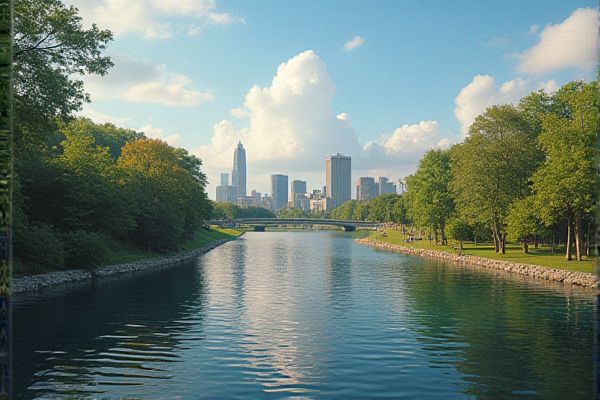
What to know as new resident in Indiana: Indiana's climate: Four distinct seasons. Cost of living: Generally affordable. State tax: Flat rate income tax. Auto Insurance: Required by law. Public Transportation: Limited availability. Cultural Scene: Vibrant arts and sports. Local Cuisine: Known for pork tenderloin. Education: Good public and private schools. Historical Landmarks: Numerous, like Indianapolis Motor Speedway. Outdoor Activities: Abundant parks and trails.
Indiana's climate: Four distinct seasons.
Indiana experiences four distinct seasons: hot, humid summers with average high temperatures around 74°F, cold winters with average high temperatures below 46°F, a cool and rainy spring, and an autumn with vibrant fall colors and crisp air, with temperatures often fluctuating significantly from day to day. To learn more about the unique climate conditions that define the Midwest, visit their blog on Midwestern Weather, which provides an in-depth exploration of regional weather patterns.
Cost of living: Generally affordable.
Indiana has a generally affordable cost of living, with average monthly expenses for a single person without rent at around $1,160 and for a family of four at approximately $4,100, excluding rent. Housing costs, food, and utilities are lower than national averages, making Indiana one of the more affordable states in the U.S.
State tax: Flat rate income tax.
Indiana has a flat state income tax rate of 3.15%, meaning all residents pay this rate regardless of their income amount. Additionally, Indiana does not offer standard or itemized deductions on state income tax. For a detailed overview of the tax brackets and available tax deductions in Indiana, you can visit the TaxAct Blog for more information.
Auto Insurance: Required by law.
In Indiana, Auto Insurance is mandatory, requiring minimum coverage of $25,000 bodily injury per person and $50,000 per accident, $25,000 property damage liability, and uninsured motorist coverage. It's essential to understand these requirements to ensure you are adequately protected while driving. However, it is noteworthy that while uninsured motorist coverage is typically part of the mandatory policy, you have the option to waive it in writing. For more detailed insights and guidance, consider visiting the Auto Insurance Guide provided by this informative website.
Public Transportation: Limited availability.
In Indiana, particularly in Indianapolis, public transportation is limited due to scarce and infrequent bus services, with many residents having no access to reliable, frequent transit. The system is underfunded, resulting in slow bus travel times and limited job accessibility outside the central area. For further information, you can check the full article on Streetsblog USA. Addressing these issues is crucial for improving the overall quality of life and economic opportunities for Indianapolis residents. The current situation demands an investment in infrastructure and a strategic plan to revamp the entire transit system to ensure it adequately meets the needs of the community.
Cultural Scene: Vibrant arts and sports.
In Indiana, particularly in Indianapolis, the cultural scene is marked by a vibrant integration of arts and sports. Events like SWISH feature live performances, public art, and basketball-themed activities, highlighting the city's collaborative approach to arts and culture. The state is renowned as the "Home of Basketball," with a rich cultural scene that celebrates the sport through various art, architecture, special events, and historical attractions, making it a unique blend of sports enthusiasm and cultural expression.
Local Cuisine: Known for pork tenderloin.
Indiana is renowned for its breaded pork tenderloin, a dish that originated at Nick's Kitchen in Huntington. Here, tenderized pork cutlets are marinated in buttermilk, breaded, and deep-fried, often served as a sandwich and considered the state's unofficial sandwich. For those looking to dive deeper into this culinary tradition, check out Indiana's Best Breaded Pork Tenderloin where you can explore the rich history and diverse establishments that celebrate this iconic dish.
Education: Good public and private schools.
In Indiana, the public school system traces back to the 1816 constitution, which was the first to establish state-funded public schools. Today, although the majority of children benefit from the public school system, around 10% choose private or parochial schools. The state boasts several large school districts, including Fort Wayne Community Schools and Indianapolis Public Schools, alongside prestigious higher education institutions such as Indiana University, Purdue University, and Ivy Tech Community College. While these larger districts are well-regarded, it's noteworthy that smaller districts often encounter challenges in providing comprehensive educational opportunities. A modest increase in enrollment can still lead to significant improvements in student performance, as detailed in an Indiana Chamber report. This underscores the dynamic nature of education and the potential for growth across different school settings in the state.
Historical Landmarks: Numerous, like Indianapolis Motor Speedway.
As a new resident in Indiana, you should know that the state is home to 44 National Historic Landmarks, including the Indianapolis Motor Speedway, which is a significant site in the state's motor racing history. These landmarks represent various aspects of Indiana's history, such as architectural heritage, historical figures, and military significance, and are all listed on the National Register of Historic Places.
Outdoor Activities: Abundant parks and trails.
As a new resident in Indiana, you can explore numerous state parks offering a variety of outdoor activities. Parks like Turkey Run State Park, Indiana Dunes National Park, and others provide extensive hiking trails, scenic views, historic sites, and opportunities for camping, fishing, and more, with many parks featuring unique natural and cultural attractions. For more detailed information about these parks, you can visit the AllTrails website, which offers a comprehensive guide to the state's outdoor offerings.
